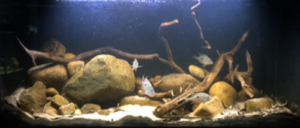Rocky part of the Rio Papaloapan River
_st place in Biotope Aquarium Design Contest 2022

Volume of aquarium: 260 litres
Dimensions of aquarium: 121cm x 46cm x 62cm
List of fishes: Thorichthys ellioti
List of plants: NA
Description of Decorations and Substrate: The biotope has fine and course quarts sand, river rocks of various sizes and shapes but mostly rounded from underwater current. Driftwood the same shape as the Zapota tree an evergreen fruit tree which runs along the banks of the Rio Papaloapan and has waterlogged and sunk and rests on the river bed. Leaf litter, detritus and sediment floating in the water column, stirred up from the strong slow moving current
Description of Equipment: Oase Biomaster 350 Thermo external filter, Fluval plant 3.0 LED 46w
Water Parameters: Temperature: 25.5c
PH: 7.8
KH: 120ppm
GH: 120ppm
Additional Info: The tank was seeded with Lumbriculus variegatus and hexanauplia for 8 weeks prior to the introduction of the fish. The tank three months on still shows signs of these crustaceans living and breeding in the environment.
Aquarium video:
Description of the Area Surrounding the Biotope: The Rio Papaloapan river or rio des las mariposas (river of the butterfly’s) is a main river of the Mexican state of Veracruz and is 220 miles long. The headwaters start in the west at sierra madre oriental and travels easterly and drains into the gulf of Mexico. The city of San Juan Bautista, Tuxtepec and Veracruz are located on the banks and surrounding area of the Rio Papaloapan and is home to 3.3 million people. A dam (cerro de oro dam) was constructed in 1989 to prevent floods to these cities which would have a massive effect on the ecology of both terrestrial and aquatic.
Description of the Underwater Landscape of the Biotope: Like most rivers the Rio Papaloapan is littered with rocks of various sizes and just sand in some parts on the river bed. The rocks and quarts sand are covered in other sediments, algae and detritus and the water column carries sediment materials which makes the water turbid. Driftwood from fallen branches and trees travel till they submerge and rest on the river floor along with leaf litter and detritus from decaying organic matter.
Description of the Habitat Parameters: The parameters of the Rio Papaloapan during the winter average at 0.13 salinity, the temperature range is lowest at 24.5c and up to 31C. The PH ranges between 6.6 and 7.8 in some parts.
List of Fishes and Invertebrates Occurring in the Nature Biotope: Priapella bonita
p. olmecea
rhamdia reddelli
atherinella
Astyanax aeneus
List of Plants Found in the Nature Biotope: no aquatic plants due to turbid water from sediments.
Threats to the Ecology of the Biotope: There are many threats to the ecology.
Natural threats: Cyclones are common in the area which could destroy buildings and start fires which could destroy forests. Floods could also was hazardous waste in to terrestrial and aquatic areas.
Human threats: Rubbish, harmful waste comes with all major cities and waterways as well as the ever growing population expansion into wild habitats with over fishing and over consumption. A dam (cerro de oro dam) was built this could have had a massive effect on the habitats that use to flood. The destruction of forests for wood and other building materials threatens aquatic and terrestrial life. Global warming is also a major threat to the habitat.
Invasive species: animals and plant life can invade areas. Mexico has been invaded by the American bullfrog, pollinating bumble bees, the black bass and the lionfish have all impacted marine and inland waters and other native pollinators in the area.
Sources of Information:
https://en.m.wikipedia.org/wiki/Main_Page
https://en.m.wikipedia.org/wiki/Invasive_species_in_Mexico
https://cichlidae.com/article.php?id=143
https://feow.org/ecoregions/details/171
https://en.m.wikipedia.org/wiki/Papaloapan_River
http://biblioweb.tic.unam.mx/cienciasdelmar/instituto/1986-3/articulo252.html
